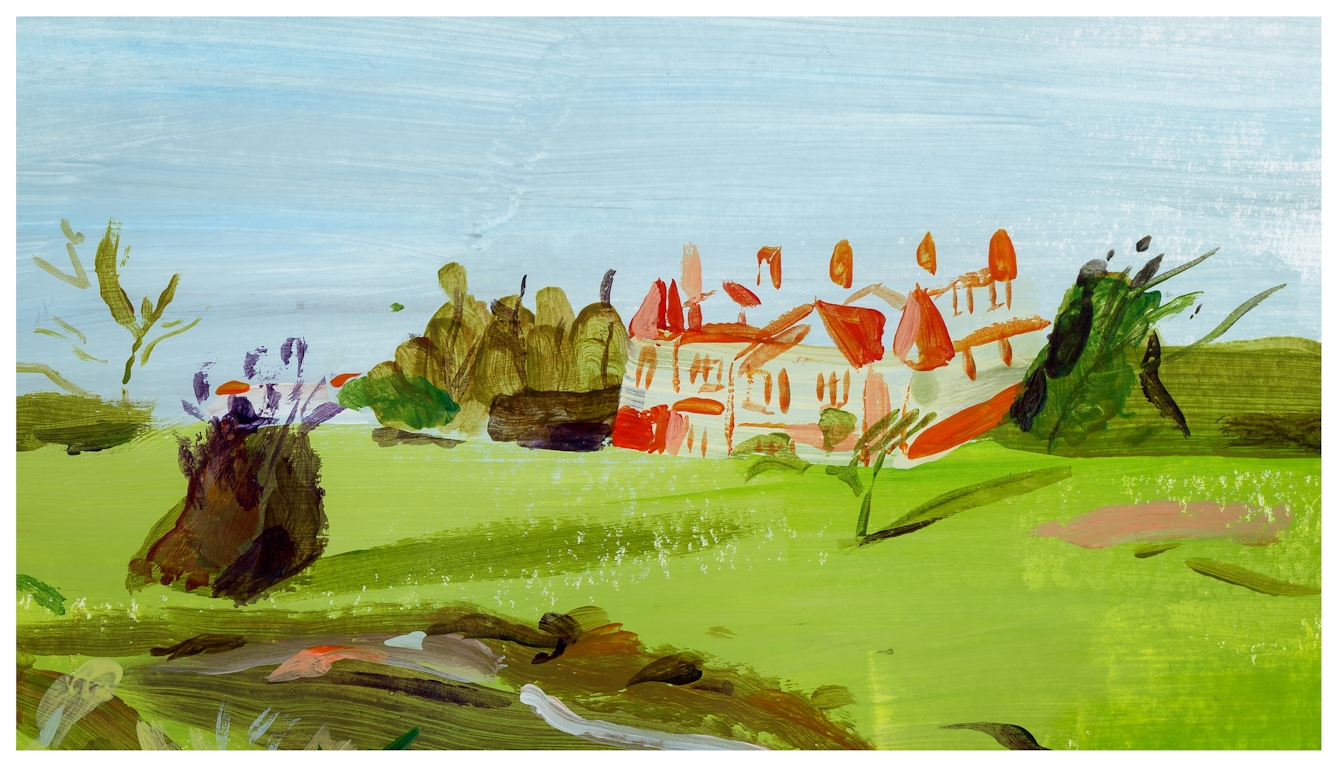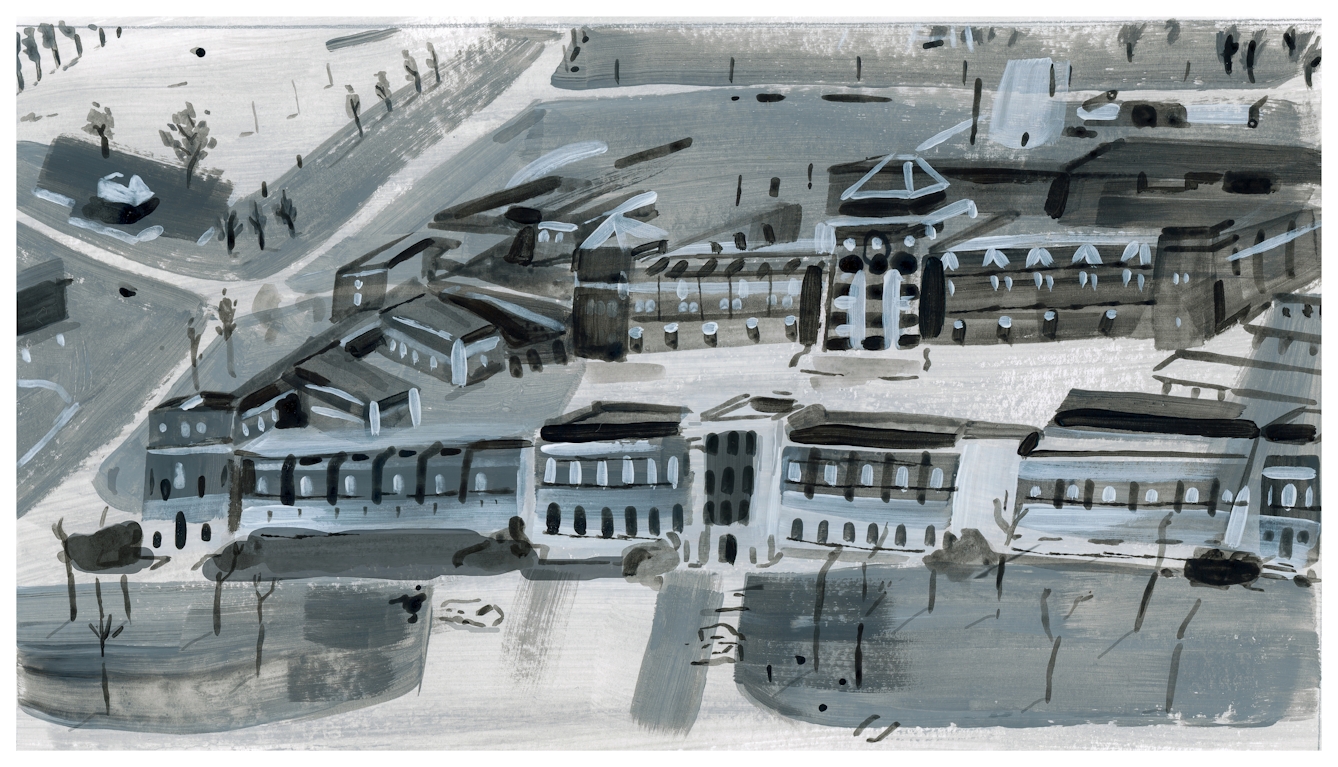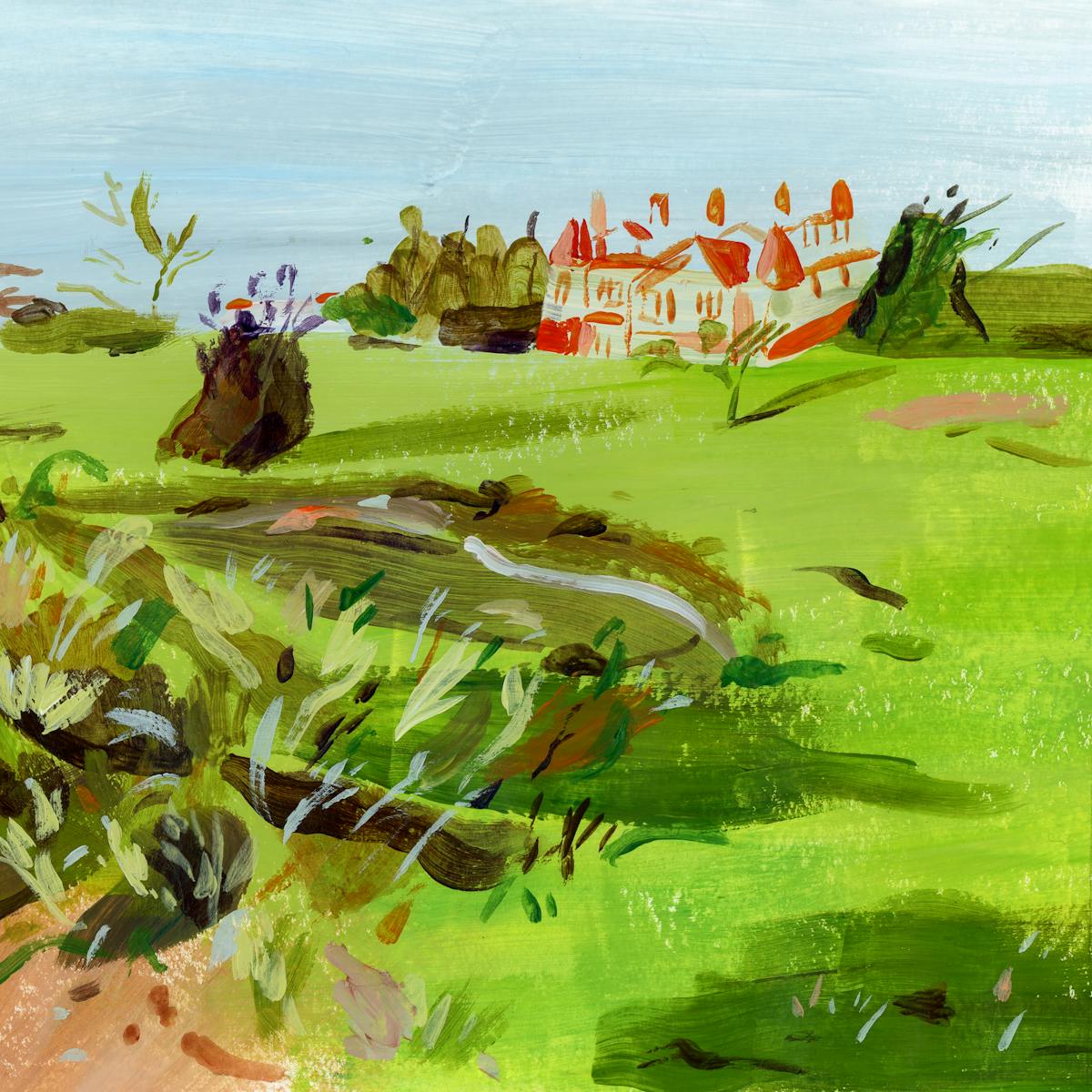In the 1900s, alcohol-addicted East Enders were sent to one of England’s first rehab centres, on Osea Island in the Blackwater estuary, where manual work and abstinence was hoped to effect a cure. Since then, a range of techniques have been endorsed by rehab facilities as the route to living a sober life, from prison, to playing music and prayer. Guy Stagg explores the history.
One autumn morning I drove to the Blackwater Estuary in Essex, a stretch of water reaching inland towards Chelmsford, lined with marshes and mudflats. The roads passed by campsites and static caravans before reaching a causeway that – at low tide – took me onto the island of Osea.
Founded in 1903, Osea was once a rehabilitation centre, one of the first in the country. Since I stopped drinking in my early twenties, I had become curious about the history of rehab. So I visited the island to better understand some of the ways people have tried to stay sober in the past.
Osea is roughly two kilometres long and one kilometre wide at its broadest point, covered in fields, woodlands, lawns and beaches. At its centre was a small village of cottages and cabins, with a large manor house that looked out over the water.
The village was built at the beginning of the 20th century by Frederick Charrington, heir to one of the largest brewing fortunes in the country. Charrington’s biography, ‘A Great Acceptance’, explains how he became a campaigner against prostitution and drunkenness after a dramatic encounter in east London.
Walking through Whitechapel one day, Charrington noticed “a poor woman with two or three children dragging at her skirts” outside a pub, begging her husband for money to feed them, only for the man to knock her to the floor. When Charrington saw his own surname above the pub sign, he renounced his inheritance and vowed to spend his life serving the people of the East End.
Over the next few decades, he set up schools, charities and an assembly hall. Osea was part of this project: a dry island with no beer, wine or spirits, where London’s unemployed men could recover from alcoholism.
Most of the men who stayed on the island had to work on the farm and its building projects. In return, they were given lodging and board, as well as an allowance – the majority of which was paid to their families.
Charrington’s “cure for inebriety” relied on three main principles. First, the idea that manual work and outdoor activity could help visitors recover by keeping them occupied and making them useful. Second, that beautiful surroundings might have a healing effect, especially the calm of an isolated island and the ‘saltings’ deposited by the estuary, which were believed to charge the air with ozone. And, third, while living on Osea there were no restrictions to freedom, meaning that visitors would hopefully feel like guests at a coastal resort, rather than prisoners or patients.
Sobriety by the seaside
Charrington was an evangelical Christian, and his “cure for inebriety” was influenced by the principles of the temperance movement. This movement began among the nonconformist churches of the 18th century, where temperance was considered part of a godly life. It aimed to reduce drunkenness in society by encouraging widespread abstinence.
Though it was clear that alcohol caused social problems, many in Victorian Britain considered teetotalism unhealthy. But, as Charrington told The Spectator, he hoped his retreat would convince people otherwise, showing that total abstinence not only lessened the desire to drink or take drugs such as opium and ether, but also gave people more energy to work.
Charrington claimed that his temperance resort would be ‘perfect’ for those “whose removal from all chance of temptation is a necessity”. “Instead of being confined within four walls, like in a prison, they will be able to roam at large for four miles,” he said in an interview with Household Words, the popular magazine founded by Charles Dickens.
But there were two categories of visitors to Osea, and they were treated very differently.
There were rumours of workmen escaping via the causeway to visit the pubs of Maldon, and of aristocratic visitors paying local fishermen to deliver bottles onto the beach.

The Causeway Retreat, Osea Island, Essex, Great Britain.
Charrington’s manor house acted as a convalescent home for wealthy men with drinking problems, who could spend their time playing billiards, walking on the beach and sailing round the island. So while the working-class residents had to follow military standards of discipline, the upper-class residents lived like guests at a country weekend.
Nonetheless, there were rumours of workmen escaping via the causeway to visit the pubs of Maldon, and of aristocratic visitors paying local fishermen to deliver bottles onto the beach.
In the end, Charrington’s experiment was cut short when the island was requisitioned by the navy during World War I.
Over the following years Osea had various owners, until a new rehabilitation centre called the Causeway Retreat was founded a century later. It was one of the most expensive rehabs in Europe, with celebrity patients including singer Amy Winehouse, but just five years later it was closed down by a health watchdog. These days the houses are let as exclusive holiday homes.
My own visit took place at the end of the holiday season, meaning the island looked a little drab. However, to those coming from the East End smog a hundred years ago, life on Osea was probably much healthier. In the 19th century, cities like London were associated with physical sickness and moral corruption, and Charrington’s holiday resort was intended to keep visitors away from vice.
Though modern addiction specialists might avoid such language, many would agree that certain habits become associated with certain places. Leaving those places can make it easier to change habits, and during the few hours I spent on Osea, I was struck by the sense of distance from the world. Here, I imagined, it would be easier to look at your life with a newfound perspective.
That said, Charrington’s approach to recovery was more moral than medical. He believed that work could rescue people from temptation, and also return them to being productive members of the economy – an idea that would influence rehabilitative systems for decades to come. Therefore, work was a virtue both from a Protestant and a commercial perspective. However, it would take another institution to begin the scientific study of addiction, and in turn help the concept of rehab to go mainstream.
Rehab and recovery in America’s prisons
During the 1920s, the American prison population boomed, thanks in part to the 1914 Harrison Narcotics Act. This made it illegal to use non-medically obtained drugs, causing a surge in drug prices and a resulting wave in crime. The government responded with the Narcotic Farm Act of 1929, described by the press as a ‘New Deal for Drug Addicts’.
The act led to the creation of two ‘narcotic farms’: one in Kentucky and the other in Texas. They were intended for people convicted of drug-related offences who were also suffering from addiction issues.
In 1935, the first farm opened outside Lexington, among the rolling hills and fertile soil of Kentucky’s Bluegrass region. The difference from Osea could not have been starker: Lexington Farm was a vast complex built from brick and concrete, with cellblocks five or six storeys high and 1,500 beds. It was surrounded by a thousand acres of farmland, and bordered with high walls and barbed-wire fences.
At this point, many people in the American prison system had drug problems. However, rehabilitation programmes were rare, and almost impossible to access for those who were incarcerated. By contrast, narcotic farms were said to be less strict than conventional jails, and also contained facilities to study and treat addiction.
Patients even received haircuts, manicures and pedicures – unthinkable in the conventional prison system at that time.
The farm followed the principles of “moral therapy”, a movement which tried to reform the American asylum system of the 18th and 19th centuries. In the case of Lexington Farm, this meant an emphasis on outdoor work and teaching useful skills like printing or automobile repair. What’s more, there were facilities for practising arts, crafts and music therapy, and gyms and pitches for playing sports. Patients even received haircuts, manicures and pedicures – unthinkable in the conventional prison system at that time.
Women were housed in a separate wing known as the Jenny Barn, where they were assigned domestic jobs such as cleaning, cooking and sewing.
Most people were sentenced to spend time at Lexington, but the farm also housed those who had voluntarily committed themselves. Both were known as ‘patients’, although the ‘vols’ were often white and middle class, while ‘cons’ were more likely to be People of Colour or to come from financially disadvantaged backgrounds. And only the former group could check themselves out whenever they wanted.
This story is told in ‘The Narcotic Farm’, a book and documentary which describes how residents rose before dawn to milk the cows, and then harvested everything from corn to kale. As well as making the institution self-sufficient and the food fresh, it also encouraged residents to be productive. That said, many residents hailed from large cities, meaning they had little use for the outdoor skills they learned.
Lexington Farm was also founded to study addiction, with a dedicated research centre opening in 1948. Here, the development of methadone for those coming off heroin was pioneered in the 1950s, and researchers also experimented with different behavioural and group-therapy techniques.
The farm’s research centre was successful. It helped to found the modern field of addiction science and its findings are still used by the scientific community today – from demonstrating that drug dependence is not limited to opioids, to profiling the psychological and physiological effects of sedatives, hallucinogens and marijuana. And, as argued in ‘The Narcotic Farm’, it also helped to establish the idea that “addiction is a chronic, relapsing disease”.

US Narcotic Farm, Lexington, Kentucky, USA.
Life on Lexington Farm
During the middle decades of the 20th century, Lexington attracted a steady stream of writers and musicians.
Famous jazz artists such as Sonny Rollins, Chet Baker and Elvin Jones spent time there, leading to claims that it boasted the best jazz band in the country. There was also a 1,300-seat concert hall and a large supply of instruments, while the orchestra of patients once performed on Johnny Carson’s ‘The Tonight Show’.
In 1946, the writer William S Burroughs came to stay, later using the farm as a setting in his novel ‘Junky’. That novel helped to popularise some of the institution’s slang, such as “taking the cure” and “on the nod”, as well as “croaker” for doctor, “hack” for guard, and “shooting gallery” for the detox ward. Yet the book gives the impression that few patients wished to escape their addiction, and most were there simply to take advantage of the institution.
Despite the strict security, it was still possible to smuggle drugs into Lexington, meaning some patients would swap addictions or even develop new dependencies. Their tricks included hollowed-out books containing needles and vials, purses with the lining cut and sewed together again, and medical kits with their contents replaced.
Patients were equally inventive when it came to exchanging love letters, since relationships were strictly forbidden.
Some women did give birth at the farm. But babies were usually put up for adoption, regardless of the mother’s wishes.
Critics claimed that few of the patients who passed through Lexington Farm successfully overcame their addictions.
Many of the studies also used methods of coercion that would no longer be considered ethical. For example, some prisoners were paid to take part in tests, others were offered reduced jail sentences, while a few trials involved deliberately addicting patients to certain substances.
Lexington Farm was also one of numerous institutions caught up in the MK-Ultra scandal, where the CIA gave money to research centres in the 1950s and 1960s to explore whether LSD could be used for mind-control purposes.
In 1975 the two narcotic farms were closed down, with funding diverted to smaller, regional rehabilitation projects. Rereading ‘Junky’, it’s easy to see the problems that could follow from sentencing hundreds of people with addiction issues to one vast institution, far from their families or homes. And it’s no surprise that the risk of relapse was high once they left the institution, given the lack of ongoing support.
Despite this, Lexington is still seen as a radical place. At the time, there was no federal or public provision of rehabilitation services, and those who worked at the farm believed they were curing those with addiction issues, rather than simply punishing them.
That said, the exploitative research and poor success rates meant that the narcotic farms never became a lasting solution. Their story is reminder of the challenges involved in freeing anyone from addiction while keeping them locked away.
Nowadays, Lexington is a federal prison for those requiring mental or medical healthcare.
Alcoholics Anonymous, group therapy and God
I have never been to rehab, but in my early twenties I spent several months attending Alcoholics Anonymous (AA). At the time I was recovering from depression, and I hoped the meetings would help me stop drinking. I was drawn to its familiar setting from films and TV: the church hall, the cups of tea, the circle of chairs.
The Big Book, the foundational text of AA, describes alcoholism as “an illness which only spiritual experience will conquer”. And the Twelve Steps – the roadmap to recovery, according to AA – require addicts to accept a ‘Higher Power’, ask it to remove their faults, and pray for guidance in life.
Attending the meetings, I was told that this Higher Power could be interpreted as God, or loved ones, or any cause you cared deeply about, but I was still confused. If addiction was a question of habit or will, it made sense that a community with shared values could help. But if addiction was an illness, then surely prayer was of little use.
AA was founded by a group of Americans who met in the 1930s while attending the meetings of a Christian revivalist movement called the Oxford Group. This movement was inspired by various strands of 19th-century Methodism, which encouraged self-examination, the acknowledgement of faults, and surrendering to divine assistance. The principles of the Oxford Group formed the basis of Alcoholics Anonymous, providing the format of AA meetings and the structure of the Twelve Steps.
The founders of AA viewed addiction as a disease. The “only relief”, they believed, was “entire abstinence”.
This claim – known as the disease model of addiction – was at least a century old when it was adopted by AA. In 1802, Christoph Wilhelm Hufeland, the famed German physician who coined the term ‘dipsomania’, compared alcoholism to an ‘infection’. In 1804, a Scottish naval physician named Thomas Trotter, who pioneered the use of inoculation for medical staff, argued that chronic drunkenness was a disease or defect. And, in 1808, the Philadelphia physician Benjamin Rush, signatory to the Declaration of Independence, claimed that “habitual drunkenness should be regarded not as a bad habit but as a disease”.

Willmar State Hospital, Willmar, Minnesota, USA.
The concept of addiction as disease proved popular among people with addiction issues, freeing many of them from a sense of guilt or shame.
That said, in post-Prohibition America, the majority still viewed drunkenness as the result of a moral failing or lack of willpower. What’s more, without any dedicated programme for recovery, most of those with drinking problems ended up in psychiatric wards, hospitals or prisons.
But, in an effort to reach as many people as possible, AA made their meetings free, voluntary, and led by those in recovery.
Rehabilitation in a residential community
Soon after World War II, a cluster of institutions on the outskirts of Minneapolis began incorporating the principles of AA into the medical establishment.
The first was a ‘guest house’ for alcoholics, originally set on Medicine Lake, and then moving to Center City. Known as Hazelden Farms, it was a white clapboard building two storeys tall, offering panelled rooms, lakeside walks, and views from the porch.
Hazelden was neither a prison nor a holiday resort. Instead, it borrowed elements from both these models, while trying to create a residential community committed to sobriety. A room cost $100 for the first week, $85 a week thereafter (at the time, the median family income was about $3,300 a year). Patients were expected to attend lectures on the Twelve Steps and group discussions on addiction, as well as encourage one another to stay sober. The original 1949 brochure claimed: “Alcoholism is recognised at Hazelden for what it is – a disease, not a moral deficiency.” And a few years later a facility for women was opened in nearby Dellwood, this one known as Dia Linn.
Meanwhile, at the Willmar State Hospital on the other side of Minneapolis, a pair of doctors began to pioneer abstinence-based treatment of alcoholism. They too emphasised that addiction was a disease, and that the cure required physical, mental and spiritual treatment – the holistic approach inspired by AA, but overseen by medical professionals. The method developed at these two institutions – with its emphasis on abstinence, the Twelve Steps, and group therapy, in a residential community supervised by clinical experts – became known as the Minnesota Model.
Since then, some 50,000 patients have passed through Hazelden. This model also spread to rehabilitation centres across the world, including famous institutions like the Priory and the Betty Ford Center. The majority of these institutions mix private patients with those in lower income brackets – NHS beds in the UK, financial aid in the USA – and insist on treating everyone the same. And AA meetings provide ongoing support once the residential part of the cure comes to an end.
The AA model of recovery has many critics. To begin with, the fellowships were almost exclusively male, and several passages in the Big Book have been called sexist. Others find the religious language alienating or unscientific, while the author James Frey – who wrote a controversial, semi-fictionalised memoir about his stay at Hazelden, ‘A Million Little Pieces’ – even argued that attending AA for the rest of your life “is the replacement of one addiction with another”.
Though I was convinced that my life would be better without drinking, I was not convinced by AA’s claim that it was the only route to sobriety.
These were some of the reasons why I stopped going to meetings. Though I was convinced that my life would be better without drinking, I was not convinced by AA’s claim that it was the only route to sobriety. Once I began to learn more about its history, I realised that many of the Big Book’s theories – the claim that addiction is a disease, or that recovery requires a spiritual component, or that lifelong abstinence is the only cure – dated back to the early days of rehab. Today, many medical professionals question the evidence for such claims, suggesting that recovery remains an inexact science.
Lessons from staying sober
It’s clear that AA and residential rehabilitation centres have helped many to achieve sobriety. However, they’re not the only options, and for some they’re not the best. For myself, looking at the history of rehab makes clear that there are multiple routes to recovery, and that different paths work for different people.
Perhaps that is the lesson of Osea, of Lexington, and of the Minnesota Model. All of these institutions had flaws, yet they shared the ambition to create places where some of those who have fallen low might be able to lift themselves up again. At the same time, many of their motives and methods belong to historical periods that have now passed, and that deserve to be left behind. However, learning about the various ways they attempted to restore people’s health can still be worthwhile, as it teaches us something about the complex phenomenon of addiction itself.
About the contributors
Guy Stagg
Guy Stagg is the author of ‘The Crossway’ (Picador, 2018), an account of walking from Canterbury to Jerusalem. It was awarded the Edward Stanford Travel Memoir of the Year and shortlisted for several other prizes. He writes about place, religion, mental health – and the ways these subjects overlap.
Jess Nash
Jess Nash is an illustrator whose work is based on her love for culture and social commentary. She has collaborated with Vans, MoMA, Penguin Random House and Untangle Grief.


